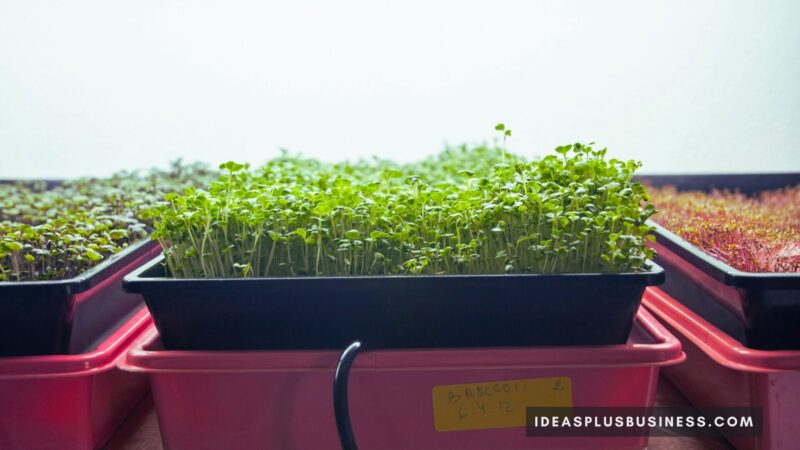Imagine growing your own lettuce on your apartment building’s roof, or strawberries climbing the walls inside a warehouse! This is the future of food in many cities.
As more and more people move to cities, there’s a growing need for fresh, healthy food that doesn’t have to travel long distances. That’s the idea behind urban agriculture, a cool trend where cities are using innovative ways to grow food within their limits.
Urban agriculture is basically farming right in the city, using clever techniques like rooftop and vertical farms. This article dives into two popular methods: rooftop and vertical farming, and how they can help cities feed their people in a sustainable way.
Rooftop Farming: Green Roofs, Big Benefits
Cities have lots of unused space on top of buildings. Think of rooftop farming as turning unused rooftops into gardens.
Farmers can grow vegetables, herbs, fruits, and even flowers on these rooftops. Instead of collecting dust, they can be bursting with life, growing all sorts of things from lettuce to peppers! This is perfect for crowded cities because it takes advantage of existing space and all that lovely sunlight, which plants need to grow.
Here’s why rooftop farms are awesome:
- Fresh, Local Food: Cities can grow their own fruits, veggies, and herbs, providing residents with healthy, delicious options right in their neighborhoods.
- Eco-Friendly Powerhouse: Rooftop gardens help cool down buildings (like a giant leafy hat!), capture rainwater, and even improve air quality by absorbing pollutants.
- Reduced Food Footprint: Since the food doesn’t have to travel long distances by truck, it cuts down on pollution caused by transportation.
Here are a few things to consider before planting a rooftop farm:
- Roof Strength: Not all buildings are built to handle the weight of soil, plants, and water. Engineers need to make sure the roof can handle the extra load before you start planting.
- Waterproofing: Roofs are designed to keep water out, not in. Rooftop farms need proper waterproofing to prevent leaks and damage to the building below.
- Upfront Costs: Building a rooftop farm can be expensive, from installing proper drainage to buying seeds and setting up irrigation systems.

Vertical Farming: Growing Up, Not Out
Vertical farming takes things to a whole new level (literally!). Imagine growing crops in tall towers, one layer on top of another. This is exactly what vertical farms do.
Vertical farming use special techniques like hydroponics (growing plants without soil) to maximize space and grow more food in less area.
Here’s what makes vertical farms stand out:
- Space Savers: They can grow tons of food in a tiny footprint, perfect for cities with limited space.
- Resource Champions: Vertical farms use much less water than traditional farming because they recycle the water they use.
- Year-Round Harvest: By controlling things like light and temperature, vertical farms can produce food all year long, no matter the season.
- Minimizing Chemicals: Since everything is grown indoors, there is less need for pesticides, making the food more eco-friendly.
These high-tech vertical farms face some challenges like:
- High-Tech Needs: Vertical farms rely on complex systems for things like lighting, temperature control, and nutrient delivery. This technology can be expensive to set up and maintain.
- Energy Consumption: All those lights and climate control systems require a lot of energy. Finding ways to power vertical farms sustainably is an important challenge.
- Limited Crop Variety: Not all plants are suited for vertical farming. Crops that need a lot of space or specific sunlight patterns might be difficult to grow in these systems.
Challenges of Urban Agriculture in the City
While rooftop and vertical farming are awesome, there are some hurdles. Setting them up can be expensive, finding space can be tricky, and there might be rules and regulations to consider.
But the good news is that as technology gets better and people become more interested in sustainable food, these challenges are being overcome. For example, researchers are developing more energy-efficient lighting systems for vertical farms, using LEDs that give off less heat and require less power.
Architects are designing new rooftop materials that are lightweight yet strong, and can handle the weight of soil and irrigation systems. Additionally, companies are developing new growing techniques that use less water and nutrients, reducing the environmental impact of both rooftop and vertical farms.
As cities grow, the need for local, fresh food will only increase, making rooftop and vertical farming even more important.

Growing Cities, Growing Solutions
Urban agriculture, especially rooftop and vertical farming, has the potential to revolutionize how cities feed themselves.
By using innovative ideas and rethinking unused spaces, cities can become hubs for sustainable food production. This can lead to a number of benefits, including increased access to fresh, healthy food for residents, reduced reliance on long-distance transportation of food (which helps to lower greenhouse gas emissions), and the creation of green spaces within urban environments.
Additionally, urban agriculture can help to improve air and water quality in cities, as rooftop gardens can help to absorb pollutants and rainwater runoff.
As urban populations continue to grow, the need for innovative solutions to food security will become even more critical. Urban agriculture offers a promising way for cities to meet this challenge. By embracing rooftop and vertical farming techniques, cities can become more self-sufficient and resilient in the face of climate change and other challenges.
With continued development and investment, urban agriculture has the potential to transform our cities into centers of sustainability, where fresh, local food is accessible to all.

I am Adeyemi Adetilewa, an SEO Specialist helping online businesses grow through content creation and proven SEO strategies. Proficient in WordPress CMS, Technical Site Audits, Search Engine Optimization, Keyword Research, and Technical Writing (Portfolio).
I help brands share unique and impactful stories through the use of public relations, advertising, and online marketing. My work has been featured in the Huffington Post, Thrive Global, Addicted2Success, Hackernoon, The Good Men Project, and other publications.

